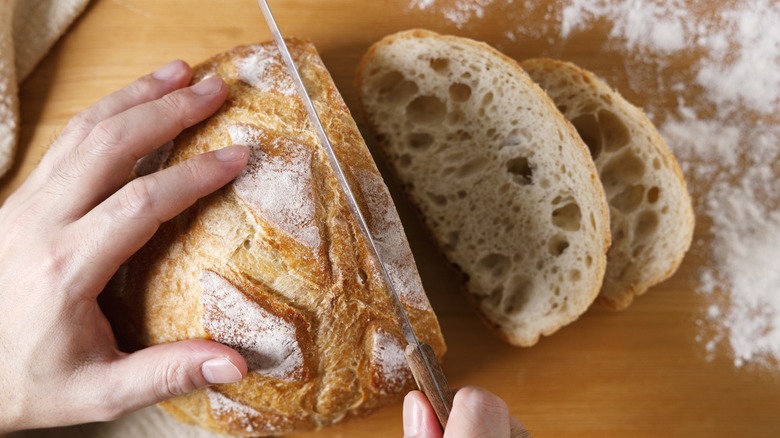What You Can Do If Your Sourdough Starter Isn't Rising
Dealing with a sourdough starter can be weirdly daunting. You're making bread out of something that is, essentially, alive: a mix of yeast and lactic acid bacteria that you have to "feed" until you're ready to put it in a hot oven and bake it until it becomes a delicious loaf of bubbly, crusty bread. It sounds pretty high maintenance, but it's really nothing to be afraid of — there's a reason why we turn to sourdough in tough times, like during the pandemic, after all. But what happens if your sourdough starter isn't rising like it should? We talked to Erik Fabian, co-founder of Sourhouse, and he told us the first step is to warm it up.
"Most [of] us like to live in cooler homes, while sourdough microbes are most happy at warmer temperatures," he said. "Find a way to warm your starter to the 'Goldilocks Zone' of 75 to 82 [degrees Fahrenheit]."
There are a few different ways to accomplish this, from feeding your starter with warm water to setting it on a heating pad; Fabian also devised a device called the "Goldie," which will maintain your starter at the correct temperature for you. Just be wary of the effect where your sourdough starter appears to stop growing after a few days. "This lull happens when the sourdough microbes are pushing out other microbes in the starter," said Fabian. "As long as your starter is warm and you are following a decent recipe, then it will start to increase in size again after that lull."
How to tell if your sourdough starter has gone off
So what is your sourdough starter supposed to look like — and, just as importantly, what is it supposed to smell like? Erik Fabian let us know, albeit not in the most appetizing way. "New starters go through a few stages from smelling like just flour, to kinda gym-socks stinky for a couple days, to eventually a pleasantly sour aroma when it is ready and at peak height." If you'd rather not smell gym socks when preparing your bread, you can also just watch to see your starter rise. "You typically judge a sourdough starter's rise by creating it in a straight-sided jar and looking for the volume increase after a feed."
If your starter isn't progressing like it should, it's not necessarily a lost cause, said Fabian. "Tired starters can look watery, gray, and flat. These starters need to be fed but aren't necessarily bad or 'dead.'" But you'd better watch out for the wrong kind of life growing in that jar. "If you see any pink/orange or fuzzy type surface molds, we recommend tossing it, cleaning the jar well, and going to a backup starter." There's nothing wrong with knowing when to throw out your sourdough starter and start anew — you'll be enjoying fresh bread and making French toast with the stale leftovers in no time.

